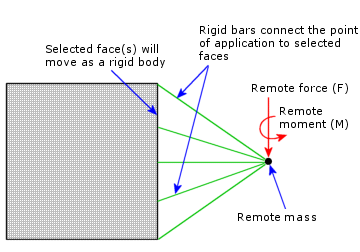Use this PropertyManager to define concentrated forces, moments, and a mass at a remote location.
A remote location is a location outside the model's geometry. You define location, a mass, forces and moments in the X, Y, and Z directions, and geometric entities connected to the specified location. The specified location is connected to the selected entities by rigid bars. The selected entities (faces,edges, and vertices), being rigidly connected to a common point, can only deform as a rigid body. High stresses can develop near faces with rigid connections.
Use this Property Manager to define a remote mass to represent one or more components that are suppressed or not defined in your geometric model. The location of the remote mass should be at the center of gravity (CG) of the un-modeled components. The mass moments of inertia are calculated with respect to a coordinate system that is centered at the CG, and has X-Y-Z axes parallel to the the X-Y-Z axes of the global, or user defined coordinate system.
The program provides an automatic way to treat a component as a remote mass.
